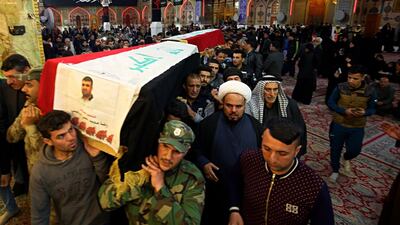Last week 27 Iraqi fighters were killed in an ISIL ambush in Kirkuk. The attack was the deadliest in the province since ISIL was driven out of Hawija in October. The ambush, targeting members of the Popular Mobilisation Units, or Hashed Al Shaabi, has created an uproar inside Iraq and even prompted politicians to call for a parliamentary discussion on ISIL’s recovery in liberated areas.
This turn of events has a number of implications worth highlighting. The first is related to how the defeat of ISIL is now perceived in Iraq. The Iraqi government made two major announcements to the effect that ISIL was finished in the country, first after the expulsion of the group from Mosul and then after it was driven out of Anbar. These operations marked the end of ISIL's hold on territory in almost all of Iraq.
As a result of the momentous gains against the group, ordinary Iraqis became convinced that chapter had ended and focus naturally began to turn to other issues. This could be discerned in discussions that have dominated since. But something of a shock happened last week. Questions began to be asked about why ISIL was still active in much of the country.
"Our intelligence and security services continue to hunt down ISIL remnants in the western desert and the Al Jazeera regions," Prime Minister Haider Al Abadi said on Tuesday, in an apparent response to rising concerns about ISIL's activities in northern Iraq. "We will not stop until we have completely eradicated terrorism from Iraq."
Which brings us to the second implication, namely dynamics related to the election season. The event could be amplified deliberately by the Prime Minister’s rivals at the election taking place on May 12 to undermine the perception of momentum mentioned above. Mr Al Abadi himself hinted at this in his speech.
“I hear talk that might be encouraging terrorism, as if [the intention is] to demoralise people and magnify the role of terrorism, as if he’s sending a message to the terrorist: ‘Strike, we will amplify it.' Do not exploit the election and encourage terrorists to carry out attacks so that you embarrass the government.”
Although the Prime Minister might be right about such opportunism, the point still stands. The political momentum established over the past few months has been challenged and the popular perception about the fight against the group has changed.
Change in perception will in return improve ISIL’s ability to project power, unlike in recent months when its attacks were barely reported beyond its Telegram channels. This third implication builds on a real trend: ISIL is indeed recovering in multiple areas in Iraq. This recovery ranges from targeted killings to improvised explosive devices to hit-and-run attacks.
Mr Al Abadi mentioned the ungoverned areas west of Mosul. Other areas include those extending from Baiji to Kirkuk, specifically the Hamrin mountains and Hawija. Diyala has also seen signs of recovery for more than a year. According to Sumaria TV, some members of parliament have called for a parliamentary session to convene and discuss the reasons behind “the return of ISIL to liberated areas”. The ISIL activities in such areas was also acknowledged by a spokesman to the international counter-ISIL coalition to Alhurra TV this week.
ISIL’s reversion to insurgency tactics, instead of simply controlling territories, has been gradually happening since early 2016. This trend plays out even in areas long liberated from ISIL, including in places liberated in 2014 and early 2015 along the Tigris river in Salahaddin.
Anecdotally, one might point to a possible pattern emerging: the longer ISIL has been expelled from an area, the more likely it can establish a gameplan for itself in that given area. Such a pattern can be explained by the militants’ ability to regroup or their decision to lay low as fighting abates.
With time, militants could familiarise themselves with the habits of the new security forces in the area, exploit a gap, establish networks or secure supplies. In the area where the ambush happened, for example, one member of parliament attributed the cause to the fact that the military was replaced by the police in securing southwestern Kirkuk. Others have mentioned the infighting in the province as a possible factor for ISIL’s ability to operate there.
A more common interpretation is that collaborators among Sunni communities in Kirkuk enabled ISIL’s mobility. (This interpretation often carries with it the suggestion that the solution is to empty such mixed areas of Sunnis, another dangerous implication if these attacks persist. It is also an obvious expression of failure and lack of appetite to deal with the underlying issues that caused the unravelling in 2014.)
ISIL, too, discussed the trend in one of its publications a few months ago. It specifically mentioned Kirkuk and Diyala as places where the group is active again. One explanation given for the apparent return of steady activities in Kirkuk, for example, was the lack of American air strikes since active frontlines ended there. This explanation aligns with the idea that the return of ISIL becomes more likely as time goes by.
Taken together, the ambush and reactions to it suggest that the gains against ISIL could be temporary. Baghdad and others involved in the fight against extremists can benefit from the current support to address problems that might cause those extremists to return.
While Iraq has a military momentum in place, it is a race against time between it and ISIL. The militants might be laying low but they will be lurking in wait for the opportunity to reconstitute themselves in areas they lost. With time, as the latest development demonstrated, momentum could erode and the group could find a new opening.
Hassan Hassan is co-author of the New York Times bestseller ISIS: Inside the Army of Terror and a senior fellow at the Tahrir Institute for Middle East Policy, Washington DC

